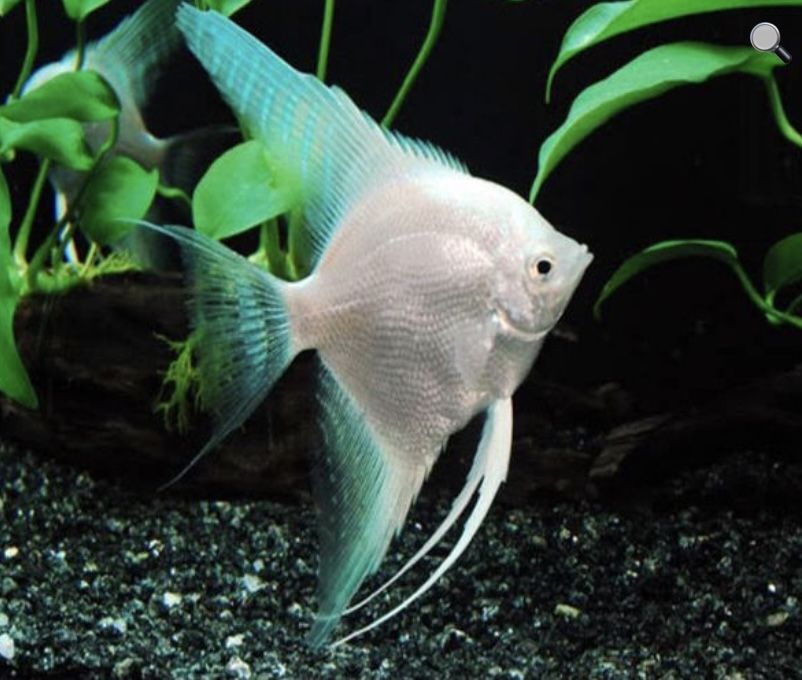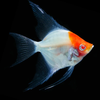You will not be allowed to compare more than 4 products at a time
View compareVendor
Angel Exotix AquariumPLATINUM ANGEL
PLATINUM ANGEL
SKU
Product Type
Out of stock
Estimated delivery: 2-3 Days from order date.
Free Shipping & Returns: On orders above €70
- Free Delivery & Free Shipping
- Secure Online Payment
Couldn't load pickup availability
More payment Option

Description
Additional Information
Fish Care
Reviews
Description
The Platinum Angel fish, Pterophyllum scalare, is a great centrepiece for a tropical aquarium. Freshwater Platinum Angelfish can grow quite large, so larger aquarium is recommended to thrive. The brightness of an angelfish’s colouring depends on its mood and stress levels. When angelfish are stressed or asleep, they can appear pale, or duller in colour. Healthy, well-nourished angelfish living in ideal water conditions will display vibrant colours.
Angelfish are popular among aquarists because of their unique arrowhead bodies and flowing fins. Although angelfish are usually peaceful, angel fish can be prone to prey upon small fish if they can fit them in their mouth, and odd fits of aggression amongst themselves or with fish of a similar size, especially during breeding season, although this aggression is commonly not fatal.
Freshwater Angelfish are overwhelmingly popular in the aquarium hobby, and its easy to see why. With their assorted color patterns and beautiful flowing fins, these fish truly live up to their name.
Angelfish are generally peaceful, although they can become territorial if there is inadequate space for them to live happily. A breeding couple may also become particularly nippy when protecting eggs or young. Be sure your tank is large enough to allow each fish to have their own space, and also be sure the tank is tall enough to allow the fish space for their longer finnage. The recommended tank size of 30 gallons is for a single fish or pair; increase the tank size for a community tank including angelfish. Beware of fin-nipping tankmates such as barbs. Angel fins are very tempting to these fish!
A tank of at least 30 gallons with ample hiding spots and open swimming areas is recommended. Their diet consists of high-quality flakes or pellets, supplemented with live or frozen foods. These angelfish can grow up to 6 inches in length and have a moderate growth rate. They are generally peaceful but can become territorial during breeding. The care level is considered moderate, requiring stable water conditions and regular maintenance. Breeding can be a rewarding experience, as they are egg layers. Maintaining good water quality and observing for signs of disease is crucial. Optimal water conditions include slightly acidic to neutral water
Angels aren't too fussy when it comes to diet. Feed them a variety such as flake or small pellets/granules once a day, changing it up with a meaty frozen food such as brine shrimp or bloodworms as their second feeding. When cared for properly, angelfish are a very friendly and rewarding species to keep!
Additional Information
The Angelfish (Pterophyllum scalare ) is a striking species among Fresh water fishes, known for its distinct appearance and unique coloration. Native to the Amazon Basin, this angelfish exhibits a beautiful blend of silvery and golden tones, often with dark vertical stripes running along its body. The striking contrast between the pale body and darker stripes gives the Angelfish a refined, elegant look, making it a popular choice among aquarists.
Angelfish thrive in warm water temperatures between 78°F and 82°F and require a tank of at least 20 gallons to swim comfortably. These fish enjoy a well-planted tank with plenty of hiding spots, as they feel more secure in an environment that mimics their natural habitat. Soft, smooth decorations are preferred, as their delicate fins can be easily damaged by sharp objects or strong currents. A gentle filtration system is recommended to maintain water quality without disturbing the peaceful nature of the fish.
Typically peaceful and non-aggressive, the Angelfish can become territorial, particularly during breeding. They are best kept with other peaceful, non- aggressive tankmates. A varied diet consisting of high-quality flakes, pellets, and live or frozen foods like brine shrimp, bloodworms, and daphnia will help maintain their health and vibrant colors.
With proper care, including regular water changes and stable water conditions, Angelfish can live 5 to 10 years. Their beautiful appearance, combined with their graceful swimming and calm temperament, makes them a stunning and serene addition to any community aquarium.
Angelfish is a fascinating aquarium fish that stands out with its vibrant colors. It belongs to the family Cichlidae and is native to the Freshwater.
This species has a care level of Moderate and requires a minimum tank size of 30 gallons (114 liters). It typically reaches a size of 5-6 inches (13-15 cm).
Preferred water parameters include a specific gravity (sg) of 1.000 - 1.010, pH ranging from 6.0-7.5, and a temperature between 78-82°F (25-28°C). Additionally, maintaining water hardness within the range of 5-12 dGH is essential.
For stocking, the recommended ratio is 1:2 M:F. The Angelfish is widely available and has a diverse diet that includes Omnivorous; will eat flakes, pellets, live foods like worms, and frozen foods like brine shrimp.
With a life span of 8-12 years, this species is known for its very easy care requirements. It is an ideal choice for both beginner and experienced aquarists. Providing a well-maintained tank environment with suitable water conditions will ensure the health and vibrancy of this captivating species.
The Best Food for Angelfish
Angelfish are easy to feed and will take all sorts of fish foods, floating or sinking. Some favorites include krill flakes, freeze-dried bloodworms and tubifex worms, and Hikari Vibra Bites. If you want to fatten up the adults to condition them for breeding, frozen bloodworms are a must-have.
Breeding Your Angel Fish?
It can be hard to spot the differences between males and females. Therefore, the easiest method of getting a breeding couple is to buy at least 6-8 juvenile angelfish, raise them to adulthood, and let them pair off naturally. Observe the Angel Fishes hanging out with the comfortable partner. Pick the best-looking pair and move them to their own Breeding aquarium for spawning. (A 20-gallon high breeding tank is a good size, since it has plenty of height for their fins to fully extend.) Once they breed, you can easily determine the sex since the female is the one laying the eggs.
How often do angelfish lay eggs?
Angelfish readily breed and can lay hundreds of eggs every one to two weeks if the eggs are removed or eaten. (The first couple of spawns often fail because the new parents can end up consuming them.) However, with the right conditions and a little patience, your angelfish can successfully raise their own offspring. The eggs are typically laid on vertical surfaces like a stiff leaf, filter pipe, or a section of aquarium wall. Depending on the tank temperature, the eggs will hatch in two to three days, and the parents may move the newly hatched wigglers (fry that cannot swim freely yet) around the aquarium with their mouths. In another three to four days, the fry become free-swimming, and the parents will protectively keep their cloud of babies between them. At this time, start off the fry with tiny, nutritious foods like baby brine shrimp.
Fish Care
Temperature - 78-82°F (25-28°C)
Breeding setups may require a slightly higher temperature of 28−30°CGeneral Hardness (GH): 3−8 dGH
Soft to moderately hard water is idealMin. Tanksize - 30 gallons (114 liters)
Water Type - 1.000 - 1.010
Suitable PH - 6.0-7.5
Slightly acidic to neutral water conditions.Native - Amazon River Basin, Brazil, North America
Fish Type - Fresh Water
Origin - Captive-Bred
Max Size - 5-6 inches (13-15 cm)
Caring - Moderate
Water Changes: Perform regular water changes to maintain stability and keep nitrate levels low.
Filtration:Use gentle but efficient filtration to maintain clean water without creating strong currents, as they are gentle swimmers
Monitoring:Regularly monitor for ammonia, nitrite, and nitrate levels to ensure excellent water quality
FAQ's
Reviews
You may also like
RED CAP ALBINO ANGEL
PLATINUM ANGEL
ALBINO ANGEL
BULGARIAN SEAL POINT ANGEL
ALTUM PERUVIAN ANGEL
BLACK ANGEL
- Choosing a selection results in a full page refresh.














